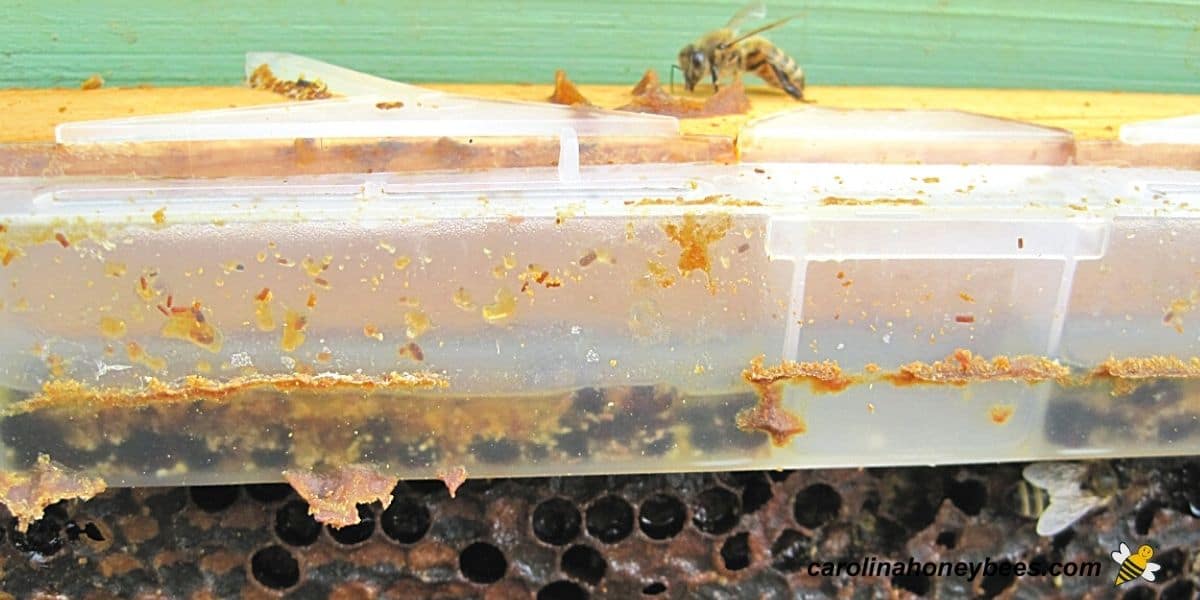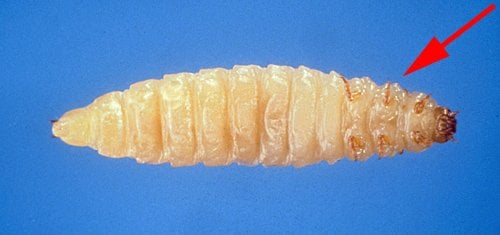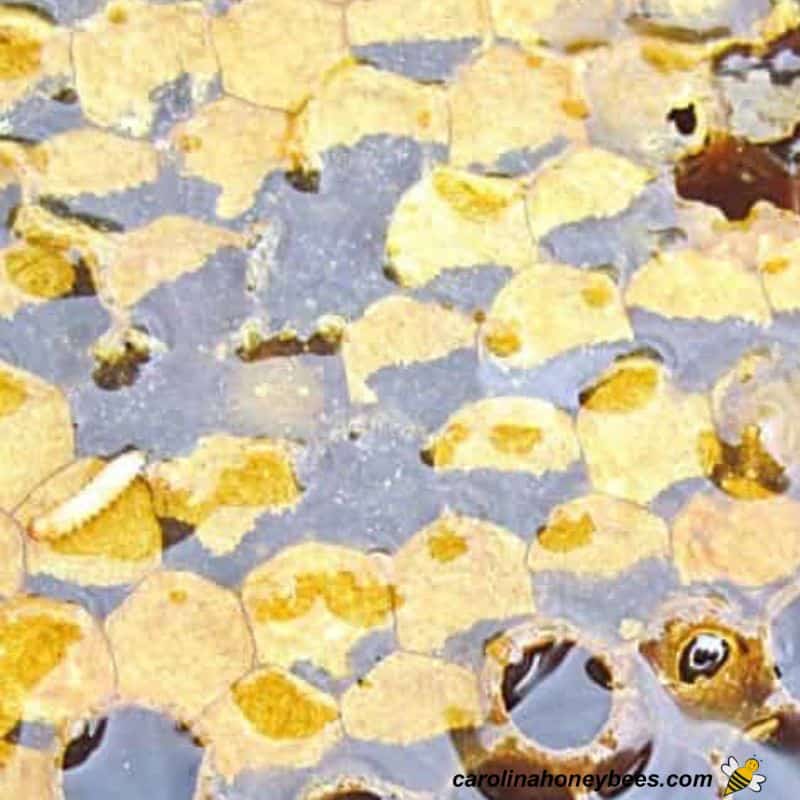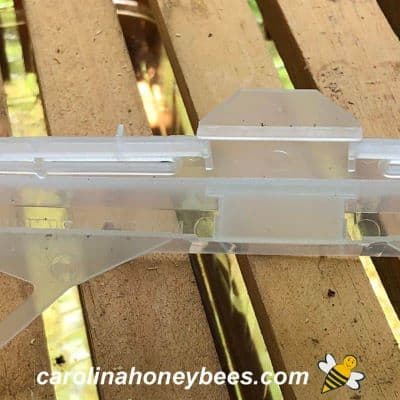Small Hive Beetle Traps and Treatments
The use of Small Hive Beetle traps are one of the easiest ways to battle Small Hive Beetles – a serious risk to honey bee colonies. Yet even with several different types of beetle traps, treatments and management methods – the battle is not an easy one. Finding the best option for your hives, requires a bit of trial and error.

As a beekeeper living in the South, I am all too familiar with Small Hive Beetles. If you don’t know them yet, count your blessings because they can be a major cause of hive failure in warm climates.
How Traps Control Beetles
Most bee colonies in southern regions will end up with some hive beetles eventually. This does not mean you should “freak out” when you see one or two of them?
But, you should always be on guard. Performing regular hive inspections, especially in the warm months, and having a management plan ( traps, treatments, management practices) in place.
Damage from Beetle Larvae
Adult beetle lays egg in comb that hatch into beetle larva. It is the larval phase of the Small Hive Beetle that causes damage in your colonies.
New beekeepers may mistake them for bee brood or the similar in appearance Wax Moth larvae.

Beetle larvae eat honey, pollen and young developing bees leaving behind feces that causes honey to ferment. If conditions get really bad, your colony of bees may decide to abscond or leave the hive.
Small Hive Beetle traps stop this reproductive cycle by capturing adult beetles before they lay eggs in the hive.

This post may contain affiliate links. As an Amazon Associate, I earn from qualifying purchases. Please read my disclosure.
Top Small Hive Beetle Traps
There are many different types of small hive beetle traps, rims and shims on the market. Most of them have several compartments.
Attractants or various types of small hive beetle bait are placed inside the trap. And, the use of mineral oil to trap and suffocate beetles is common as well.
The idea is to lure the adult hive beetle inside the trap – where they will not be able to get out. Let’s look at a few popular models.
- beetle jail
- beetle blaster
- sonny-mel beetle trap
- oil trays
- Swiffer pads
The Beetle Jail – Reusable Beetle Trap

The Beetle Jail – is currently my favorite hive beetle trap. It is re-usable – though kinda gnarly to wash out. But, I do like the fact I can use it again and again – less waste or discarded plastic in the landfill!
Beetle jails are designed to hang between the frame parts of the hive. It is common to use two in the brood box – near the edges.
This is a sturdy trap that sits recessed between the top bars. Beetle jails have 3 compartments – 2 of them have a small slit in the top. As bees chase the adult beetles- the beetles hopefully scurry inside the slit.
How to Use
Fill the 2 larger compartments about 1/3 – 1/2 full of mineral oil, vegetable oil or beetle oil. This is not bait – it is mean to trap the adults. Take care when installing and removing – you do not want to spill oil in the hive.
Some beekeepers report success in using DE or Diatomaceous Earth in the larger compartments instead of oil. If you try this, be careful – DE also kills bees.
The smaller middle compartment can be used for small hive beetle bait – though I normally don’t bother. You can add a bit of pollen, or some apple cider vinegar for bait.
The Beetle Blaster -A Disposable Beetle Trap
This disposable beetle trap, known as the Beetle Blaster, was designed by an American Company. Mr. Laurence Cutts was a lifetime beekeeper and retired Florida State apiary inspector.
He wax also a heck of a nice guy (whom I had the pleasure to meet one time) and he knows more than I could ever hope to about Small Hive Beetles.

How to Use
This trap hangs between the frames much like the Beetle Jail. It should also be partially filled with oil but has no compartment for bait.
You must carefully pour a small amount of oil in through the slots in the top. Have a paper towel or similar to clean the oil off the top before placing in the hive.
Not as sturdy or reusable as the beetle jail, this trap is less expensive and designed to throw away. Their low price does help cut some beekeeping costs.
However, it is a bit flimsy and takes a little care to push down between the frames. Be gentle but firm. They must sit down in between the top bars to work.
Even then – some beetles will hide under the rim between the wooden top bar and the plastic trap top. Run your hive tool along the top to squish anyone hiding there when doing inspections.
Sonny-Mel Beetle Trap – Homemade Option
This homemade hive beetle trap has been successful in some locations. To make one: use a small plastic sandwich container and drill small 1/8″ holes around the sides – not quite at the bottom.
Add a layer of mineral oil inside the box. Also, glued inside the box is another small container (often a bottle cap). Inside the bottle cap a liquid beetle bait is placed.
Beetle bait recipe:
- 1 cup of water
- 1/2 cup of apple cider vinegar
- 1/4 cup of sugar
- peel of 1 ripe banana- chopped into small pieces
Allow the beetle bait recipe to ferment for a couple of days before adding to the trap. The sandwich trap is placed on the top bars inside the hive.
Of course, use of this trap makes it necessary to place a shim (wooden frame) or extra super on the hive to make space. A small one the same size as a thin candy board for a hive will work.
Oil Tray Traps
Some beekeepers experience success with oil traps placed under the hive. These trays (with oil inside or even DE) are placed under a screened bottom board.
Some styles completely replace the bottom board. Their trays are situated in a way that prevents the bees from adding propolis and making them non-removeable.
Notable models are the West Trap and the Freeman Beetle Trap. Both fit under the hive and contain a tray to hold the oil.
The idea is that beetle larva (and maybe some varroa) will fall into the trap and be unable to leave. I don’t prefer this type of trap due to the expense and mess but you may like to give it a try.
Swiffer Pads for Beetle Control
A newcomer in Small Hive Beetle traps is the use of pads. These pads are placed on the top bars inside the hive.
As, the bees try to remove them from the hive it causes the pad to become very fuzzy – and grabby. Adult beetles become trapped in the fuzz -but most bees escape.
Some beekeepers experience success with the use of unscented dryer sheets or unscented Swiffer Pads as hive beetle traps.
These can be effective, I have tried the Swiffer pads and the commercial bee pads and found both to work. My issue with them is that they do catch and kill some bees.
And for myself, they made the already stuck together boxes harder to separate. Keep in mind that we do not know the effect on the bees from any chemicals in the sheets not labeled for bee use.
Advantages of Using Beetle Traps
Prevention is the best method of Small Hive Beetle Control. Preventing adults from laying eggs in the hive results in no developing beetle larvae to cause damage.
This is where our arsenal of hive beetle traps come into play. We want to prevent the adult Small Hive Beetles from laying eggs in the first place.
We may be unable to keep the adults out. But, trapping some of them quickly, helps your colony control the number inside.
Those of us in regions where this pest is common, often keep several beetle traps in the hive during the Summer. In fact, it is not a bad idea to place a couple in there once the weather starts to warm. Be proactive.
Other Treatments
In addition to using small hive beetle traps, there are a few other strategies the beekeeper can use for beetle control. They do not all work well in all locations. Focus is on controlling the developing beetle larvae or kills adult beetles.
- preventing larval development
- chemical control of adult beetles
When Hive Beetle larvae are ready to pupate and become adults-they must leave the hive and burrow into the soil.
This is a sensitive time when we may be able to stop their development. If these larvae never reach adulthood, beetle populations do not increase as quickly in your apiary.
GardStar Ground Drench
GardStar® 40% EC is applied as a soil drench that prevents beetle larva from developing into adults.
Application may last 30 days depending on soil type, ph. and rain. It is not effective in areas with a lot of rainfall. Care must be taken to not allow any drift onto the entrance of the hive as bee deaths may result.
Nematodes
Beneficial predatory nematodes (Heterorhabditis Indica) are commercially available to add to your soil. If beetles are a serious problem in your area, this is one idea to consider.
This method has not worked well in my hard clay soil but you may have better results where you live. You can not use just any kind of nematodes – some varieties do a better job of grub control but are not suited for hive beetle larva.
Chemical Control
For beekeepers trying to get rid of Small Hive Beetles, there are not many chemical options. In fact, only one is approved for use in beehives at this time. This is the chemical “coumaphos” – often sold under the name – Checkmite+.
Checkmite+ for Hive Beetle Control
Checkmite+ (coumaphos) chemical strips are placed inside small boxes with slits. Beetles go into the boxes to hid and are exposed to the coumaphos.
Considered a “hard” chemical, I don’t know any beekeepers who use it. I would not use this in my hives. But, if you are involved in a major beetle battle this might be the only option.
Be sure to wear protective chemical resistant gloves (not your beekeeping gloves) and follow the instructions from the manufacturer.

Other Methods of Controlling Beetles
Beyond these, there are other beekeeping practices to help your bees deal with beetle infestations.
- practice clean beekeeping
- place hives in full sun
- don’t use heavy mulch – avoid moist ground
- avoid giving bees too much space
- reduce entrance size
While working in the bee yard, don’t throw down bits of wax and other hive debris. This practice attract beetles, skunks and other predators. And the aroma, encourages adult hive beetles.
Adult Small Hive Beetles prefer hives in shady locations. Therefore, placing hives in the sun may be of some benefit.
Keep the ground near your hives clean. Using a hive stand is a good idea for several reasons. It is easier on your back while managing your hive. And, it is easier to keep the area around the base of the beehive clean.
If you choose to put something under your hives – don’t use heavy mulch or allow thick grass to grow. This encourages moisture and make it easier for beetle larvae to enter the ground.
A hive with a lot of bee boxes (supers) must have a large enough population to patrol all of the comb surface. Only add another super when the bees need it.
If you are experiencing a severe problem with beetles, reducing the entrance of your hive may help. Guard bees will attempt to chase adult beetles out.
They are not normally successful but it is always a good idea to use an entrance reducer on the hive entrance during times of stress for the colony.

FAQs
Honey bees can not throw all the beetles out of the hive. SHB can “hunker down” and tuck in their head and legs.
Most traps have several compartments. The larger areas are designed for the trapping oil. Common oils are : vegetable oil, mineral oil or a special beetle oil that is supposed to serve as an attractant.
A few traps have a special bait compartment. It is not a requirement to use bait in a trap. As they scurry around the hive trying to escape the bees, some beetles will go into the trap – and hopefully not make it back out.
Adults are attracted to the odors of honey, pollen and even worker bees.
SHB (Aethina tumida) are native to sub-saharan Africa but they have spread to other parts of the globe.
In addition to laying eggs in and on the comb, Hive Beetles also place clusters of eggs in cracks and crevasses inside the hive. Their eggs are about half the size of a bee egg and very difficult to see.
A Final Word
You can imagine the challenges of trying to keep a tiny flying beetle out of a beehive – while allowing the honey bees to come and go. Once the beetle infestation grows out of control, no amount of Small Hive Beetle Traps will be able to make a difference.
There is no perfect way to get rid of Small Hive Beetles. Our goal is to limit the adult beetles inside the hive. Thus limiting the number of beetle larvae present to do damage.

